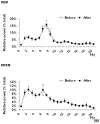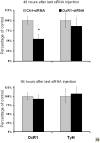Knockdown of orexin type 1 receptor in rat locus coeruleus increases REM sleep during the dark period
- PMID: 21089218
- PMCID: PMC3058252
- DOI: 10.1111/j.1460-9568.2010.07401.x
Knockdown of orexin type 1 receptor in rat locus coeruleus increases REM sleep during the dark period
Abstract
The locus coeruleus (LC) regulates sleep/wakefulness and is densely innervated by orexinergic neurons in the lateral hypothalamus. Here we used small interfering RNAs (siRNAs) to test the role of LC orexin type 1 receptor (OxR1) in sleep–wake control. In sleep studies, bilateral OxR1 siRNA injections led to an increase of time spent in rapid eye movement (REM) sleep, which was selective for the dark (active) period, peaked at approximately 30% of control during the second dark period after injection and then disappeared after 4 days. Cataplexy-like episodes were not observed. The percentage time spent in wakefulness and non-REM (NREM) sleep and the power spectral profile of NREM and REM sleep were unaffected. Control animals, injected with scrambled siRNA, had no sleep changes after injection. Quantification of the knockdown revealed that unilateral microinjection of siRNAs targeting OxR1 into the rat LC on two consecutive days induced a 45.5% reduction of OxR1 mRNA in the LC 2 days following the injections when compared with the contralateral side receiving injections of control (scrambled) siRNAs. This reduction disappeared 4 days after injection. Similarly, unilateral injection of OxR1 siRNA into the LC revealed a marked (33.5%) reduction of OxR1 staining 2 days following injections. In contrast, both the mRNA level and immunohistochemical staining for tyrosine hydroxylase were unaffected. The results indicate that a modest knockdown of OxR1 is sufficient to induce observable sleep changes. Moreover, orexin neurons, by acting on OxR1 in the LC, play a role in the diurnal gating of REM sleep.
Similar articles
-
Knockdown of orexin type 2 receptor in the lateral pontomesencephalic tegmentum of rats increases REM sleep.Eur J Neurosci. 2013 Mar;37(6):957-63. doi: 10.1111/ejn.12101. Epub 2013 Jan 3. Eur J Neurosci. 2013. PMID: 23282008 Free PMC article.
-
REM sleep changes in rats induced by siRNA-mediated orexin knockdown.Eur J Neurosci. 2006 Oct;24(7):2039-48. doi: 10.1111/j.1460-9568.2006.05058.x. Eur J Neurosci. 2006. PMID: 17067300 Free PMC article.
-
Hypocretin-1 modulates rapid eye movement sleep through activation of locus coeruleus neurons.J Neurosci. 2000 Oct 15;20(20):7760-5. doi: 10.1523/JNEUROSCI.20-20-07760.2000. J Neurosci. 2000. PMID: 11027239 Free PMC article.
-
The regulation of sleep and wakefulness by the hypothalamic neuropeptide orexin/hypocretin.Nagoya J Med Sci. 2013 Feb;75(1-2):29-36. Nagoya J Med Sci. 2013. PMID: 23544265 Free PMC article. Review.
-
Effects of changes in energy homeostasis and exposure of noxious insults on the expression of orexin (hypocretin) and its receptors in the brain.Brain Res. 2013 Aug 14;1526:102-22. doi: 10.1016/j.brainres.2013.06.035. Epub 2013 Jul 3. Brain Res. 2013. PMID: 23830852 Review.
Cited by
-
Differential actions of orexin receptors in brainstem cholinergic and monoaminergic neurons revealed by receptor knockouts: implications for orexinergic signaling in arousal and narcolepsy.Front Neurosci. 2013 Dec 20;7:246. doi: 10.3389/fnins.2013.00246. eCollection 2013. Front Neurosci. 2013. PMID: 24391530 Free PMC article.
-
Translational approaches to influence sleep and arousal.Brain Res Bull. 2022 Jul;185:140-161. doi: 10.1016/j.brainresbull.2022.05.002. Epub 2022 May 10. Brain Res Bull. 2022. PMID: 35550156 Free PMC article. Review.
-
Distinct effects of IPSU and suvorexant on mouse sleep architecture.Front Neurosci. 2013 Dec 10;7:235. doi: 10.3389/fnins.2013.00235. eCollection 2013. Front Neurosci. 2013. PMID: 24368893 Free PMC article.
-
Understanding how discrete populations of hypothalamic neurons orchestrate complicated behavioral states.Front Syst Neurosci. 2015 Aug 4;9:111. doi: 10.3389/fnsys.2015.00111. eCollection 2015. Front Syst Neurosci. 2015. PMID: 26300745 Free PMC article. Review.
-
Orexin 2 Receptor Antagonism is Sufficient to Promote NREM and REM Sleep from Mouse to Man.Sci Rep. 2016 Jun 3;6:27147. doi: 10.1038/srep27147. Sci Rep. 2016. PMID: 27256922 Free PMC article. Clinical Trial.
References
Publication types
MeSH terms
Substances
Grants and funding
LinkOut - more resources
Full Text Sources





